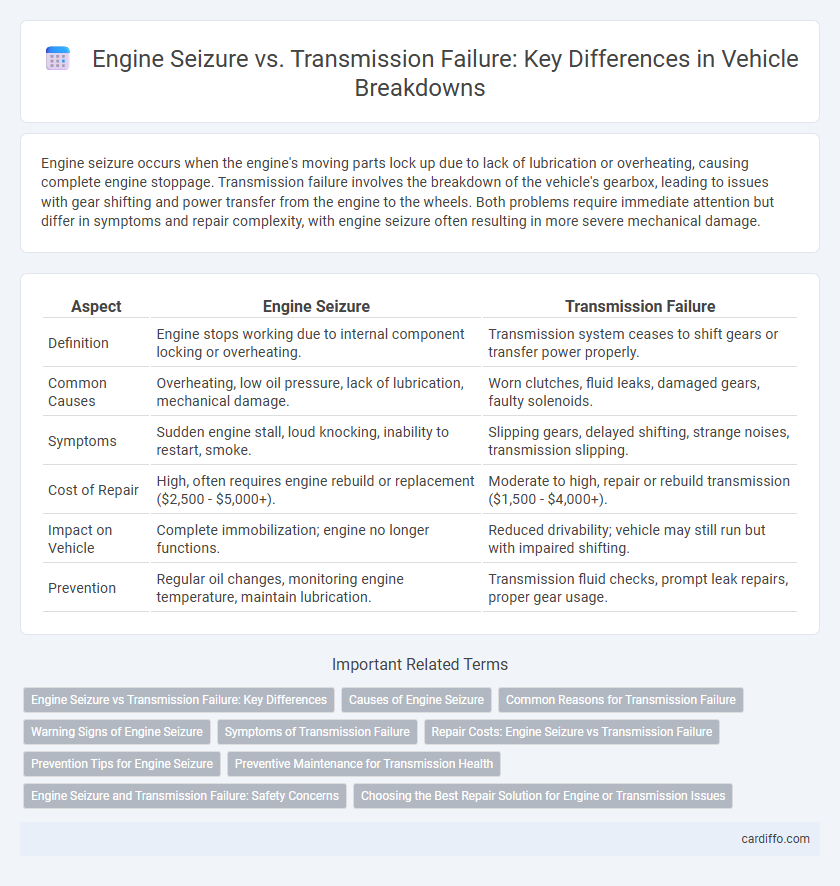Engine seizure occurs when the engine's moving parts lock up due to lack of lubrication or overheating, causing complete engine stoppage. Transmission failure involves the breakdown of the vehicle's gearbox, leading to issues with gear shifting and power transfer from the engine to the wheels. Both problems require immediate attention but differ in symptoms and repair complexity, with engine seizure often resulting in more severe mechanical damage.
Table of Comparison
| Aspect | Engine Seizure | Transmission Failure |
|---|---|---|
| Definition | Engine stops working due to internal component locking or overheating. | Transmission system ceases to shift gears or transfer power properly. |
| Common Causes | Overheating, low oil pressure, lack of lubrication, mechanical damage. | Worn clutches, fluid leaks, damaged gears, faulty solenoids. |
| Symptoms | Sudden engine stall, loud knocking, inability to restart, smoke. | Slipping gears, delayed shifting, strange noises, transmission slipping. |
| Cost of Repair | High, often requires engine rebuild or replacement ($2,500 - $5,000+). | Moderate to high, repair or rebuild transmission ($1,500 - $4,000+). |
| Impact on Vehicle | Complete immobilization; engine no longer functions. | Reduced drivability; vehicle may still run but with impaired shifting. |
| Prevention | Regular oil changes, monitoring engine temperature, maintain lubrication. | Transmission fluid checks, prompt leak repairs, proper gear usage. |
Engine Seizure vs Transmission Failure: Key Differences
Engine seizure occurs when internal components like pistons, bearings, or crankshaft overheat or lose lubrication, causing the engine to lock up and stop functioning. Transmission failure involves issues with the gearbox, such as worn gears, clutch problems, or hydraulic malfunctions, leading to difficulty shifting or complete loss of power transmission. Understanding these key differences helps in accurate diagnosis and targeted repair strategies for vehicle breakdowns.
Causes of Engine Seizure
Engine seizure primarily occurs due to insufficient lubrication, causing metal components to overheat and fuse together. Overheating from coolant loss or a faulty cooling system also contributes significantly to engine seizure. Contaminated oil, worn bearings, and excessive engine load further increase the risk of engine components locking up.
Common Reasons for Transmission Failure
Common reasons for transmission failure include low or contaminated transmission fluid, which leads to overheating and inadequate lubrication, causing internal component damage. Worn clutch plates and damaged gears often result from prolonged driving at high speeds or frequent stop-and-go conditions. Neglecting regular maintenance, such as fluid changes and filter replacements, accelerates wear and increases the likelihood of costly transmission breakdowns.
Warning Signs of Engine Seizure
Warning signs of engine seizure include sudden loss of power, unusual knocking noises, and excessive overheating. Drivers may notice the engine refusing to turn over or a grinding sound during startup attempts. Immediate attention is crucial to prevent severe damage and costly repairs.
Symptoms of Transmission Failure
Transmission failure symptoms include difficulty shifting gears, slipping gears, and delayed or harsh gear engagement. Drivers may notice fluid leaks, strange noises such as grinding or whining, and a burning smell indicating overheating. Warning lights on the dashboard often illuminate, signaling the need for immediate inspection to prevent further damage.
Repair Costs: Engine Seizure vs Transmission Failure
Engine seizure repair costs typically range from $1,500 to $4,000 due to extensive internal damage requiring major component replacement or a complete engine rebuild. Transmission failure repairs can fluctuate between $1,200 and $3,500, often involving fluid changes, clutch replacements, or full transmission rebuilds depending on severity. Both failures incur high labor costs, but engine seizures generally demand more expensive parts and longer downtime.
Prevention Tips for Engine Seizure
Regularly check and maintain engine oil levels and quality to prevent engine seizure by ensuring proper lubrication and cooling. Replace oil filters and change engine oil according to manufacturer recommendations to avoid the buildup of sludge and contaminants that cause engine wear. Monitor engine temperature closely and fix any cooling system leaks or malfunctions promptly to prevent overheating, a leading cause of engine seizure.
Preventive Maintenance for Transmission Health
Engine seizure and transmission failure are critical breakdowns that can result from neglected preventive maintenance. Regularly checking transmission fluid levels, ensuring proper fluid quality, and inspecting for leaks significantly reduce the risk of transmission failure. Implementing scheduled transmission servicing, including filter replacement and system flushes, enhances transmission health and prevents costly repairs.
Engine Seizure and Transmission Failure: Safety Concerns
Engine seizure poses significant safety risks due to sudden power loss, which can cause loss of vehicle control and increase the likelihood of accidents. Transmission failure often results in slipping gears or inability to shift, creating dangerous situations especially at high speeds or on inclines. Both engine seizure and transmission failure require immediate attention to prevent hazardous driving conditions and ensure vehicle safety.
Choosing the Best Repair Solution for Engine or Transmission Issues
Engine seizure and transmission failure both demand prompt diagnosis to determine the most effective repair solution, with engine seizure often requiring a complete engine rebuild or replacement due to internal damage like piston or crankshaft failure. Transmission failure may involve costly repairs such as clutch replacement, fluid flushes, or a full transmission overhaul depending on the severity of gear slippage or fluid leaks. Selecting the best repair involves evaluating repair costs, vehicle age, and performance impact, with professional diagnostics providing a clear path to either engine or transmission restoration.
Engine seizure vs transmission failure Infographic

 cardiffo.com
cardiffo.com